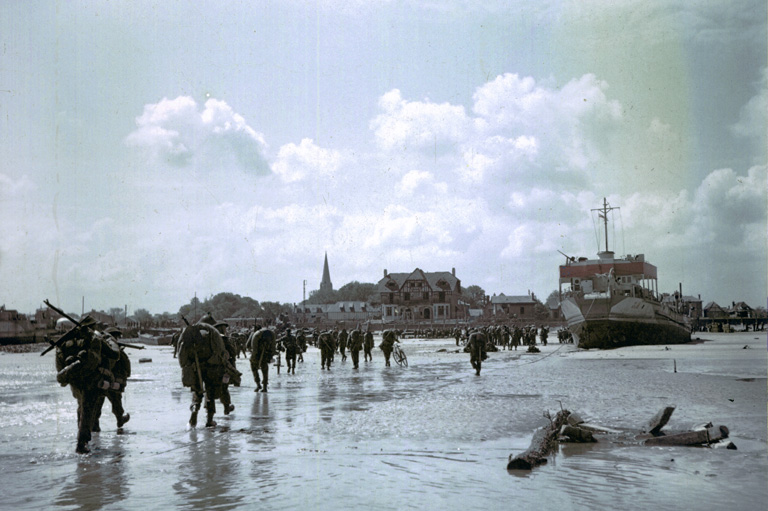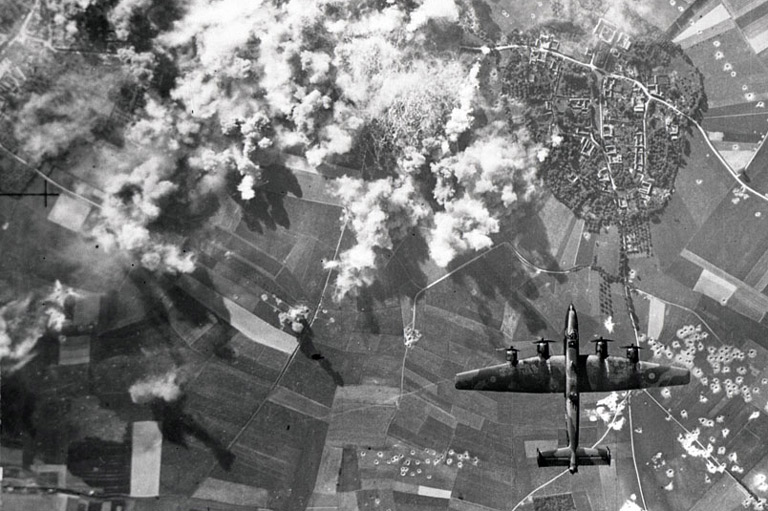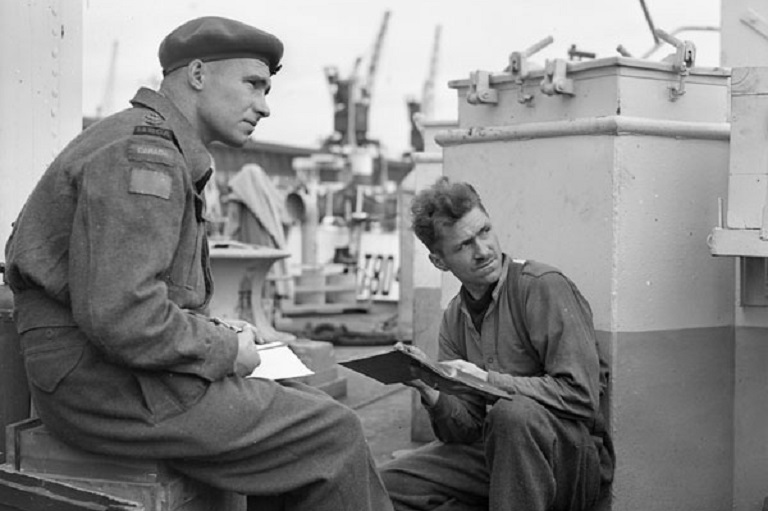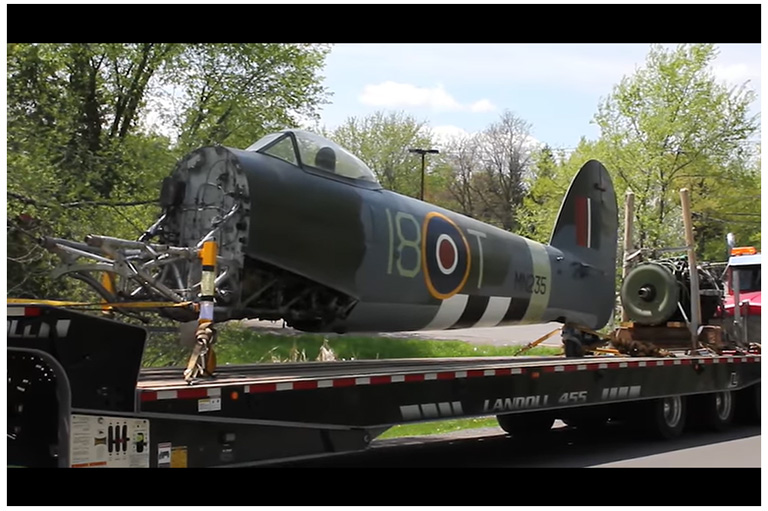By Every Means Possible
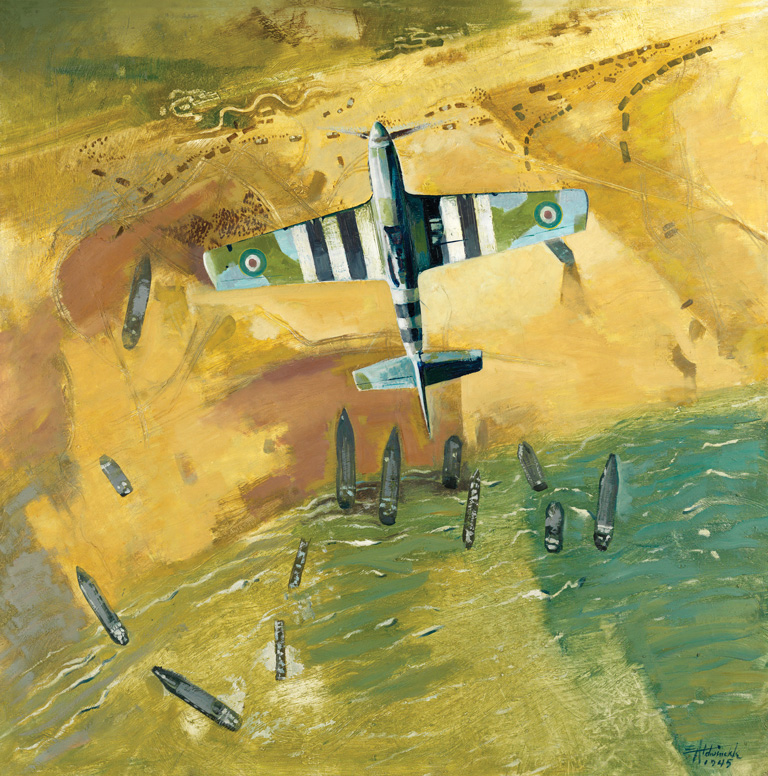
The success of the D-Day invasion of France on June 6, 1944 — an immense operation and the largest seaborne assault in history — was made possible only by weeks of intensive operations in which Canadians played crucial roles.
Much has been written about the significant role the Canadian Army played in the D-Day invasion, and rightly so. But there was much more to Operation Neptune — the crossing of the English Channel and the landing on the beaches — and to Operation Overlord — the plan for the liberation of Normandy — as the two key parts of the invasion were codenamed.
Canadian sailors and airmen had very substantial roles in the prelude to and the weeks after D-Day, roles that have usually been neglected.
Five American, British, and Canadian divisions landed from the sea, and three airborne divisions dropped inland. The 3rd Canadian Infantry Division and the 2nd Canadian Armoured Brigade made up the Canadian part of the assault, touching down on Juno Beach and successfully establishing themselves ashore.
Meanwhile, the 1st Canadian Parachute Battalion, part of the 6th British Airborne Division, landed inland to seize bridges. The aims of the air force were to establish and maintain air supremacy over Normandy and to find and attack enemy formations at the same time as road and rail communications were disrupted and the bombing of Germany continued.
At sea, the objective was to protect the D-Day landings and the subsequent supply and reinforcement shipping from surface and U-boat attacks.
Of prime importance in making the D-Day landing possible were the minesweepers, which had the critical task of clearing German minefields off the French coast. The mines posed the biggest threat to the success of Operation Neptune, and the Allies had 247 minesweepers to clear ten lanes for the invasion fleet.
The Royal Canadian Navy’s 31st Minesweeping Flotilla provided ten Bangor-class minesweepers under Canadian command, with six more ships serving under the Royal Navy in three other flotillas. The RCN’s Bangor minesweepers had until then played a role in protecting convoys, rather than minesweeping, and their crews had to be trained by the Royal Navy for their primary task.
Under the leadership of Lieutenant-Commander A.H.G. Storrs, the Canadians practised hard from mid-March of 1944. Storrs remembered the British “sucking their teeth wondering if these Canadians are really up to it.”
They were, though they suffered one major disappointment: The RCN crews had hoped to clear the way for the 3rd Canadian Division’s landing on Juno Beach; instead they were assigned to clear a lane for the Americans to land on Omaha Beach.
The minesweepers’ first task was to prepare a safe path through the English Channel.
Their second task was to clear ten lanes, each a kilometre wide, through the dense minefield that stretched a dozen kilometres wide, fifty kilometres from shore across the Baie de Seine. Between that minefield and the French shore were thousands of randomly placed mines, and the third task was to clear these.
One officer of HMCS Georgian said, “We were to hold our course, no matter what was ahead — there must be no holes in our sweeping as ships loaded with troops would be following on us, and would be depending on us.”
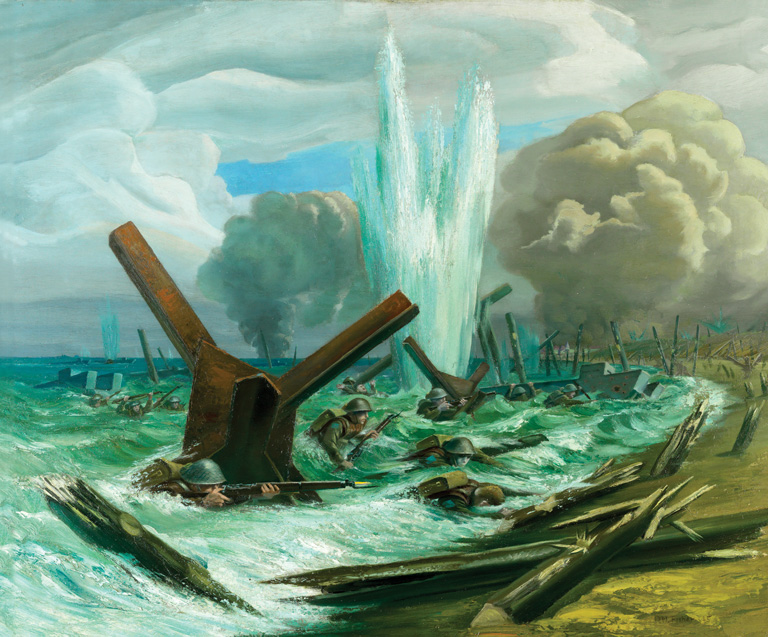
The minesweeping flotilla entered the enemy minefield at 7:00 p.m. on June 5, 1944. Preceded by shallow-draft British launches that cleared a narrow belt of mines, the Bangors swept in what has been described as a snowplow formation to cut loose more than a hundred mines that were allowed to drift away.
If they had been destroyed as in the usual practice, the Germans ashore would have heard the explosions and learned of the planned invasion. Following the minesweepers, small boats laid buoys to mark the swept channel. Once through the minefield, the flotilla proceeded to clear lanes to the invasion fleet’s anchorage and then cleared the anchorage itself.
The final job, beginning at 1:05 a.m. the next morning, was to sweep lanes for the assault boats to within 2.5 kilometres of the landing beach. Astonishingly, as Canadian Sub-Lieutenant William G. Morrow reflected, the lack of German reaction “was almost unbelievable.”
He credited the German failure to respond to “the enemy assuming it was just a feint, another one of the routine sweeps that they had become accustomed to.” The minesweeping operation was a great success, and the RCN had played an important part.
Canada’s navy also played a significant support role after the landing was established ashore. RCN destroyers close to shore remained in radio contact with the troops ashore.
When Le Régiment de la Chaudière, the reserve battalion in the 3rd Division’s 8th Brigade, moved inland on Juno Beach, the infantrymen found themselves held up by a battery of three deadly 88-mm guns. A radio message quickly whistled up support from HMCS Algonquin, one of some 110 Canadian ships involved in D-Day.
The Tribal-class destroyer fired fifteen shells from its 12-cm guns, of which a remarkable thirteen landed right on target, and the infantry moved ahead unmolested. Naval gunfire continued to be enormously effective so long as the front lines remained in range — as they did for the following month.
If there were great successes, there were failures, too.
The Allies’ air forces and the naval bombardment signally failed to destroy the Germans’ Normandy beach defences. The Royal Winnipeg Rifles, tasked with landing on Juno Beach on D-Day, found that the defences had not been knocked out by air or naval bombardment.
“As the landing craft approached the beach,” the regimental history tartly observed, “it was increasingly clear that the bombardment had failed to destroy any of the enemy strongpoints.”
The Little Black Devils (as the regiment was nicknamed) hit the beach and suffered heavy casualties, but they nevertheless eliminated the resistance. It was the same story for the Queen’s Own Rifles. One company landed in front of a deadly 88-mm gun that had survived the bombardment untouched; another QOR company found itself facing an intact and heavily manned concrete bunker and lost half its men before knocking out the machine guns and gunners.
Only their courage and training saved the day.

The air role was nonetheless hugely important.
Royal Canadian Air Force crews, flying from No. 6 Group, and their comrades in Bomber Command had been raiding German industrial cities for months.
Along with United States Army Air Force raids, these around-the-clock efforts forced the Germans to concentrate their interceptors and anti-aircraft artillery to protect their homeland.
This dramatically reduced the aircraft and flak guns available to the German Luftwaffe in northern France: There, the Germans had a mere 319 planes against the Allies’ 11,000 or so, ensuring the Allies’ total air superiority.
The Luftwaffe only rarely engaged in combat before or after D-Day — and when it did it suffered heavy losses against the better-trained Allied pilots.
On May 22, for example, Canadians shot down five German aircraft. The bombers also hit at rail and road targets in France in what was called the Transportation Plan.
Attacks intensified beginning on May 21, and every effort was made to spread out the attacks so as to confuse the enemy about the intended landing sites.
The Germans expected the inevitable invasion to come in Pas-de-Calais, so targets there were heavily attacked — sometimes more often than in Normandy.
Railway traffic was disrupted across all of northern France, and marshalling areas were regularly hammered. On June 6, RCAF bombers struck at the marshalling yards at Coutances on the Cherbourg peninsula.
That day, a bomb that had been dropped from above passed through one of the wings of Flight Lieutenant Tony Selfe’s big four-engine Halifax bomber. Selfe turned for home, desperately struggling for some hours to stay in the air.
His aircraft was on the verge of crashing into the sea — “I guess we’ve had it,” he told his crew — until he regained control and some altitude. “Maybe we haven’t,” he reconsidered.
At 180 metres, the crew bailed out over England. Selfe landed hard near a stone wall and gravel pit, and all his mates survived. As he recalled of the near miss, “I was somewhat terrified myself but fortunately was too busy to do my brooding.”
While Selfe survived, Pilot Officer Andrew Mynarski did not.
A mid-upper gunner, Mynarski was aboard a Canadian-built Lancaster bomber from the RCAF’s No. 419 Squadron that was on a Transportation Plan mission over northern France just after midnight on June 13. Over Cambrai, a Luftwaffe Ju-88 night fighter raked it from below and behind with machine gun fire and set the Lancaster on fire.
The pilot ordered the crew to parachute to safety, but one of Mynarski’s comrades was trapped in the tail gun turret. Mynarski went through flames to try to free him but failed. The tail gunner finally told him to get away while he still could, and Mynarski, with his flight suit and parachute on fire, turned, saluted his comrade, and jumped.
Astonishingly, the tail gunner survived the crash of the aircraft, but Mynarski, badly burned and gravely wounded, died in a German military hospital.
The twenty-seven-year-old Winnipeg native received the Victoria Cross posthumously for his valiant efforts to save his fellow crew member.

The Allies’ overwhelming air power resulted in devastating consequences for the enemy.
In the first place, the German air force proved completely unable to interfere with the invasion and its aftermath. From June 6 through to the end of the month, the Luftwaffe sank only five vessels, the largest a destroyer, and damaged another seven.
Over five thousand ships had been crowded into the narrow confines of the English Channel and the Normandy beachhead, but so overpowering was Allied air superiority that the Luftwaffe had almost no effect.
The Transportation Plan attacks, such as those by Selfe’s and Mynarski’s aircraft, reduced French rail traffic to twenty per cent of what it had been in January 1944, and the RCAF’s No. 6 Group delivered one third of the destructive attacks that forced Berlin to admit that “large-scale strategic movement of German troops by rail is practically impossible.”
On August 1944, both Bomber Command and United States Army Air Force bombers struck at German positions between Caen and Falaise as the First Canadian Army’s II Canadian Corps moved south in a major drive to trap large enemy forces.
Lieutenant-General Guy Simonds’ operations Totalize and Tractable relied on heavy bombing “to force the survivors to keep their heads down,” or so the Bomber Command crews — including many Canadians in No. 6 Group — were told.
Operation Totalize utilized both American and Bomber Command aircraft, and some 24 USAAF bombers accidentally dropped their payloads on Canadian and Polish troops, causing heavy casualties. Six days later, more than 800 bombers, including 227 from the RCAF, took part in support of Operation Tractable.
Of those, 126 aircraft, including 44 from the RCAF, bombed Canadian troops, again killing and wounding many. The ground attacks went ahead despite the casualties, but more German troops escaped the Falaise Pocket than had been hoped by the Canadian and British commanders.
Bomber support was essential, and it terrified the enemy; but it was too often a blunt weapon in tactical situations, and there was always the risk of friendly fire casualties. The Allied air forces’ tactical aircraft, especially Typhoons and P-47s, had a greater impact as the invasion progressed.
On D-Day, Germany’s powerful Panzer Lehr Division received orders to move from the Chartres area in France to block a British thrust towards Villers-Bocage. But air attacks on June 7 caught the division on the way and destroyed more than 130 trucks and fuel tankers, five tanks, and eighty-four self-propelled guns and half-tracks.
A few days later, Allied intelligence pinpointed the headquarters of Panzer Group West sitting unprotected in an orchard south of Caen. This headquarters, under the command of General Leo Geyr von Schweppenburg, was being watched closely by Allied intelligence, as it had moved forward to assume command of all available panzer forces for a decisive counterattack against the Allied landing.
With many of its squadrons and air crew from the RCAF, the Second Tactical Air Force of the British Royal Air Force quickly mounted a major strike.
On June 10, forty Typhoons and sixty-one Mitchell bombers attacked the target, devastating the headquarters. Eighteen officers, including the chief of staff, were killed outright, and von Schweppenburg was badly wounded. The headquarters was withdrawn to Paris, and the massive German armoured counterattack never took place.
Field Marshal Erwin Rommel, commanding the German efforts to contain the invasion, tersely summed up the situation his forces faced:
“Our own operations are rendered extraordinarily difficult and in part impossible to carry out [because of] the exceptionally strong and, in some respects overwhelming, superiority of the enemy air force. The enemy has complete command of the air over the battle zone and up to about 100 kilometres behind the front and cuts off by day almost all traffic on roads,” Rommel complained.
“Neither our flak nor the Luftwaffe seem capable of putting a stop to this crippling and destructive operation of the enemy’s aircraft.”
The field marshal was himself severely wounded when his staff car was shot up by Canadian and British fighter bombers in August.
The Germans greatly feared the RCAF, RAF, and USAAF fighter bombers that attacked their road traffic, and Allied claims that the Jagdbombers — or Jabos, as the enemy called them — had destroyed countless armoured vehicles were loudly shouted.
Certainly, the Normandy battlefields were cluttered with destroyed panzers and assault guns. However, later close examination by operational research teams revealed that the wreckage was most often caused by ground fire, mechanical defects, destruction by the tank crews, or a lack of fuel (the shortage of which was substantially caused by air attacks on German and French targets).
This conclusion was almost certainly correct; yet the Jabo attacks severely weakened enemy morale, forced tank crews and other troops constantly to seek shelter when the aircraft were overhead, and caused much destruction among trucks and horse-drawn transport.

The RCAF and RCN also played important roles in the war against the Kriegsmarine, the German navy. Again, the aim was to prevent surface vessels ranging from destroyers to motor torpedo boats and submarines from interfering with the invasion and its resupply. Here as well, Allied superiority was manifest.
One weapon was the Royal Air Force’s Coastal Command, which hunted German surface ships and U-boats. The enemy had thirty-six U-boats in ports on the Bay of Biscay on June 6, and Coastal Command’s priority was to block these vessels from attacking the invasion fleet.
The enemy submarines carried heavy flak guns, and in the first twenty-four hours after sailing on D-Day they shot down a number of low-flying anti-submarine aircraft. Those included a Wellington of the RCAF’s No. 407 Squadron, the loss of which resulted in the deaths of six Canadians, and two Liberator bombers, also with the loss of RCAF personnel.
But there were also great successes at sea. In the early morning hours of D-Day, a Liberator bomber flown by Flying Officer Kenneth Moore of the RCAF spotted a U-boat on the surface at the western edge of the English Channel, its target apparently the invasion fleet.
The Liberator, its crew of ten including seven Canadians, attacked at a height of fifteen metres, engaged the submarine with machine gun fire, and dropped six depth charges.
As Moore reported, the “U-boat was observed to lift out of the sea and disintegrate and was then hidden from view as plumes rose up to full height.” That was one kill.
Thirty minutes later, Moore’s aircraft spotted a second U-boat and attacked it with depth charges and machine guns. The submarine listed heavily, its bow reared out of the sea, and it slipped beneath the waves. When the Liberator circled back, it spotted the surviving U-boat crew in dinghies.
Moore’s aircraft had sunk two German submarines in a single sortie, an apparently unique feat. Moore received the Distinguished Service Order, an extremely rare distinction for a junior officer, and others in his crew were also decorated.
Submarines were not the only menace to be attacked from the air. The enemy’s E-boats, or motor torpedo boats, were fast and agile, and they had some success after D-Day, sinking a few small freighters and landing craft. But on June 14 Bomber Command struck at the harbour at Le Havre, on the Channel, destroying fourteen boats.
Another raid the very next day, on Boulogne, destroyed more of the fast craft and effectively ended the threat for the month of June. Both bombing raids unfortunately also killed French civilians.
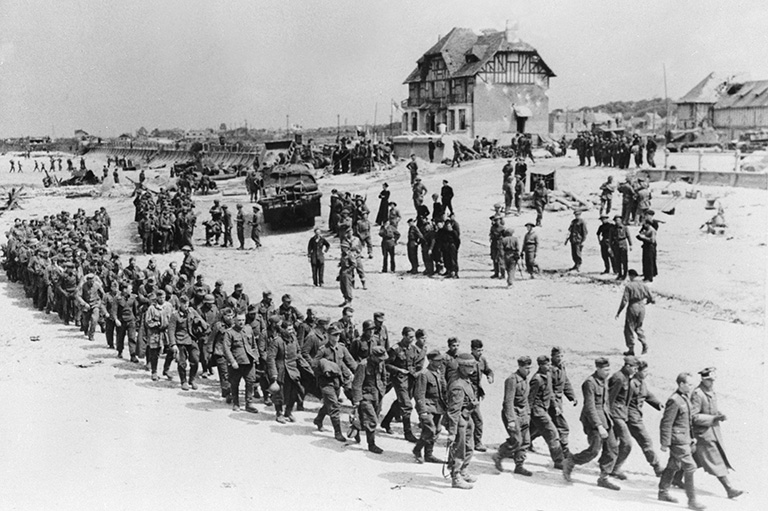
The battle against German surface craft had begun before D-Day and was also fought by the Royal Canadian Navy’s Tribal-class destroyers HMCS Haida, Athabaskan, and Huron, which were operating in French waters under Royal Navy command.
On April 25, Canadian and British ships spotted three German Elbing-class small destroyers returning to Saint- Malo from a mine-laying mission. The Germans scattered, but the Haida’s and the Athabaskan’s guns sank one enemy ship.
Two nights later, the surviving German vessels bumped into Haida and Athabaskan again.
One of the German ships launched torpedoes, hitting Athabaskan and sinking it. Haida in turn sank one of the German ships, then turned to rescue as many of the crew members of its sister ship as possible. The Athabaskan’s captain, Lieutenant-Commander John Stubbs, was in the water and waved Haida off, shouting, “Get away Haida! Get clear!” He feared that it would be attacked.
The navy’s official history notes, “This selfless gesture has become one of the few heroic traditions that the Canadian navy, noted more for understatement than bravado, has preserved.” Stubbs and 128 of his crew died, but the Haida (along with the Germans) saved 91 Canadian sailors.
The Haida and the Huron continued operations, and on June 8, two days after D-Day, they encountered the Kriegsmarine’s last major effort to attack the invasion fleet.
Their Royal Navy comrades dealt with one German destroyer, and the two RCN ships opened fire on another. One shell hit the enemy vessel in its turbine room, and three more hits put its forward turret out of action.
The German destroyer continued to resist, using its one remaining turret and firing torpedoes that missed the Canadian ships, before grounding itself on the French shore. This sea battle ended the post-D-Day threat to the invasion fleet, and in August two of the few surviving German surface vessels were destroyed in air attacks by Beaufighters from the RCAF’s No. 404 Squadron and from an RAF squadron.
Operations Neptune and Overlord were combined operations making use of every method to defeat a strong enemy. The American and British forces provided the bulk of Allied strength, but Canada — its population only 11 million during the Second World War, with 1.1 million men and women in uniform — contributed heavily.
The Canadian Army, the Royal Canadian Air Force, and the Royal Canadian Navy all played substantial and distinguished roles, with the Dominion’s soldiers, sailors, and airmen sharing in the victory in Normandy.
Themes associated with this article
Advertisement
You might also like...

Canada’s History Archive, featuring The Beaver, is now available for your browsing and searching pleasure!
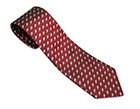
Beautiful woven all-silk necktie — burgundy with small silver beaver images throughout. Made exclusively for Canada's History.



